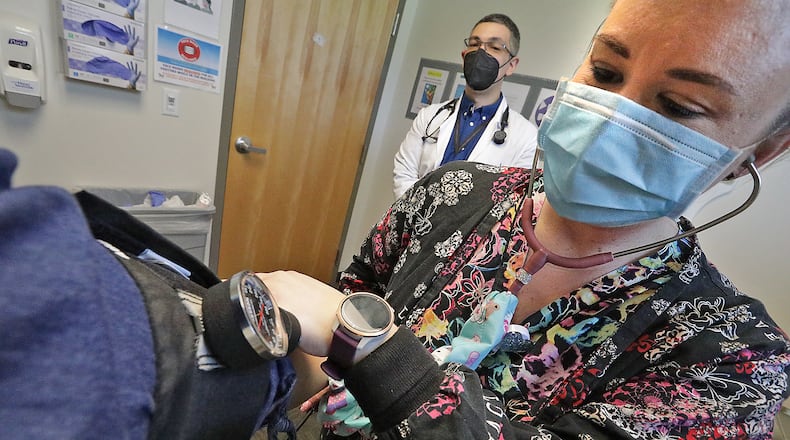“No matter where you live, there is still work to be done to create conditions so that everyone in the community thrives,” said Amanda Gatewood, a scientist with County Health Rankings & Roadmaps.
Local officials say where people live matters when it comes to their health. But many groups are working together to address root causes of unhealthy behaviors and help people lead better lives.
“In public health, the greatest correlation with health overall is socio-economic status,” said Champaign County Health Commissioner Gabe Jones. “I think one thing here we have, being in a rural county, is limited options when it comes to healthcare resources.”
Of Ohio’s 88 counties, Clark County ranks 79 for health outcomes and 66th for health factors, according to the County Health Rankings data. Champaign County ranks 36 for health outcomes and 41 for health factors.
Delaware, an affluent county north of Columbus, was the healthiest in the state, while Scioto County, a small rural county in Appalachia, is the least healthy, the report states.
Health outcome rankings are based on data about premature deaths and the percentage of babies born with low birthweights, as well as the share of residents with poor or fair health and the amount of time they recently had poor physical or mental health.
Health factors rankings were determined using a wide range of metrics about drug, alcohol and tobacco use, diet and exercise, access to health care, quality of care, level of education, employment, income, air quality, housing, crime levels and other conditions and behaviors.
Health officials respond
Champaign County’s health district has the goal of becoming the healthiest county in the state, said Jones. Although it’s difficult to say the county’s Community Health Improvement Plan (CHIP) directly contributed to this year’s ranking, preventative efforts have contributed to health improvements, he said.
In Champaign County, 24% of residents smoke, 38% of adults are obese, 29% are physically inactive and 13% of children live in poverty, according to County Health Rankings.
The health district has multiple groups that focus on education and prevention for issues related to chronic disease, substance abuse, mental health and early childhood wellness.
The Healthy Living group, for example, has been working to raise awareness surrounding nutrition and create better access to physical activity.
In terms of health outcomes, chronic diseases are the biggest issues public health leaders face in Champaign County, Jones said.
In addition, a group focused on children’s health and success has been working to ensure kids in Champaign County are prepared for kindergarten.
“Ensuring children are where they need to be from a health standpoint and then from an education standpoint: that’s a really important focus for us,” Jones said. “Setting them up for success early tends to have much better outcomes later in life.”
Clark County has rested in the lower middle range or lower range of counties in Ohio for the past several years. Health Commissioner Charles Patterson said that the health district has been working to move the community forward.
But it may not see an increase in ranking for a few years, given the impact of the opioid epidemic, which began locally around 2015, peaked between 2017 and 2018, and saw a resurgence during the COVID-19 pandemic, he said.
One of the most significant factors in calculating health outcomes is “years of life lost,” which measures the number of years people collectively fall short of their life expectancy. Data used to calculate the rankings span back five years.
Chris Cook, assistant health commissioner, said the life expectancy in Clark County — roughly 74 years — is younger than the state (76.5 years) and national (80.6) life expectancies.
“It’s partially our environment, it’s partially decisions we’re making, but Clark Countians are not living as long as the rest of Ohio and the nation,” he said.
Credit: Bill Lackey
Credit: Bill Lackey
Dr. Yamini Teegala, chief medical officer at the Rocking Horse Community Health Center, agrees. Because the environments where people are born, live and work negatively impacts health, the Center is taking a new approach when seeing patients, she said.
“We are approaching this new diagnosis from the angle of caring for them in an interdisciplinary team Model involving not just providers but multiple supportive personnel,” she said.
Clark County outpaces the state and nation in terms of diabetes, with the county’s rate being 12%; the state’s, 10%; the country’s, 8%, Cook said.
According to Clark County’s health rankings, 25% of residents smoke, 41% of adults are obese, 31% are physically inactive and 21% of children live in poverty.
Preventative work is being done to address health issues in Clark County. Patterson said the health district has been working through the Start Strong coalition to prevent infant death, low-birth weight and teen pregnancy locally.
“We’re looking to maternal and infant health, we’re looking to prevent chronic diseases,” Patterson said. “The main focus of the health department is on prevention.”
The health district is also working with the Springfield city commission to delay people from starting to smoke through the Tobacco-21 ordinance. Research shows that the longer you hold people off from starting to smoke, the less likely they will become smokers in their adulthood. This also lowers their risk for cancer, Patterson said.
The county health rankings also point to local progress in measures related to clinical care, such as decreasing the number of uninsured people in the county, increasing mammography screening and increasing the number of people getting vaccinated for the flu in Clark County.
Cook said the County Health Rankings may not be a perfect model, but it serves as a tool for health districts, and calls people to action.
“I think this should rally us as a community to do better,” he said. “It’s all of our responsibilities to look at this: not just as a game plan for us here at the health department, but for individuals as well.”



